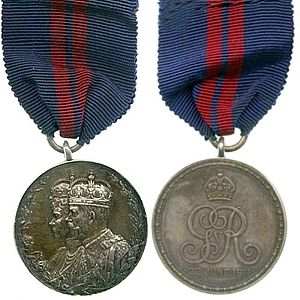King George V Coronation Medal
| King George V Coronation Medal | |
|---|---|
 Obverse and reverse of the medal | |
| Type | Commemoration medal |
| Description | Silver |
| Eligibility | Commonwealth citizens |
| Clasps | None |
| Established | 1911 |
Ribbon bar | |
| Related | George V Police Coronation Medal Delhi Durbar Medal, 1911 Visit to Ireland Medal 1911 |
The King George V Coronation Medal was a commemorative medal instituted in 1911 to celebrate the coronation of King George V, that took place on 22 June 1911.
Award
It was the first British commemorative medal to be awarded to people who were not in attendance at the coronation[1] and, as well of those involved in the ceremony, it was given to selected dignitaries, officials and members of the armed forces, both in Britain and across the Empire.
On 30 June 1911 a special ceremony was held in the grounds of Buckingham Palace for King George V to present medals to all members of the Colonial and Indian contingents who had represented the overseas troops in the Coronation procession. The ceremony lasted two hours, medals being handed by the King to each of the 300 recipients present.[2]
For this and subsequent Coronation and Jubilee medals, the practice up until 1977 was that United Kingdom authorities decided on a total number to be produced, then allocated a proportion to each of the Commonwealth countries and Crown dependencies and possessions. The award of the medals was then at the discretion of the local government authority, who were free to decide who would be awarded a medal and why.
A total of 15,901 medals were awarded,[2] including 286 to Australians.
Recipients who were also eligible for the 1911 Delhi Durbar Medal received the Coronation medal only, and wore a crowned clasp inscribed 'DELHI' on the ribbon.[1]
In addition, a Police Coronation Medal, of a different design and ribbon, was awarded to police officers on duty during the official Coronation celebrations.[2]
Description
- The medal was designed by the Australian sculptor Bertram Mackennal.[2]
- All awards were in silver, the medal being 32 millimetres (1.3 in) in diameter.
- The obverse has a profile of King George V and his wife Queen Mary in coronation robes, facing left.
- The reverse has the crowned Royal Cypher above the date of the coronation, 22 June 1911.
- The 32 millimetres (1.3 in) wide ribbon is dark blue with two thin red stripes in its centre. Awards to ladies have the ribbon in the form of a bow.[3]
- The ribbon for the police version of the medal is red with three narrow blue stripes.
References
- ^ a b John W. Mussell, editor. Medal Yearbook 2015. p. 287 Published Token Publishing Limited, Honiton, Devon. 2015.
{{cite book}}:|author=has generic name (help) - ^ a b c d Cole, Howard N. Coronation and Royal Commemorative Medals. pp. 29–30. Published J. B. Hayward & Son, London. 1977.
- ^ Captain H. Taprell Dorling. Ribbons and Medals. p. 110. Published A.H.Baldwin & Sons, London. 1956.
